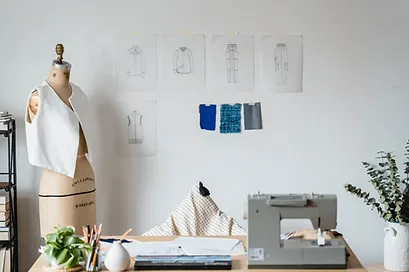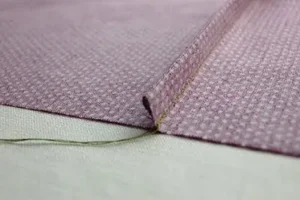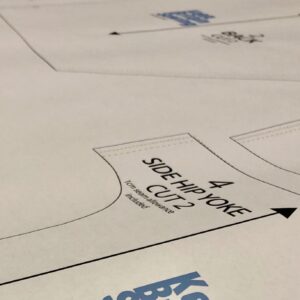Sewing is a timeless craft that allows you to unleash your creativity and create beautiful, one-of-a-kind pieces. Whether you’re interested in making clothing, home decor items, or accessories, learning how to sew is a valuable skill that can bring immense satisfaction and a sense of accomplishment. In this ultimate guide for beginners, I will share essential tips and advice to help you embark on your sewing journey with confidence.
Jump to a section:
Why sewing is a great hobby for beginners
Essential sewing tools and equipment
Choosing the right fabric for your project
Understanding basic sewing techniques
Tips for reading and using sewing patterns
Common sewing mistakes to avoid
Sewing tips for improving your skills
Sewing project ideas for beginners
Sewing resources and tutorials for beginners
Why sewing is a great hobby for beginners
Sewing is an ideal hobby for beginners for several reasons. Firstly, it is a versatile craft that offers endless possibilities. From simple repairs and alterations to complex garments and decorative items, sewing allows you to express your unique style and bring your creative visions to life. Additionally, sewing is a practical skill that can save you money in the long run. Instead of constantly buying new clothes or home furnishings, you can mend and create items tailored to your preferences.
Moreover, sewing provides a therapeutic outlet for stress relief and relaxation. The rhythmic motion of stitching and the focus required to complete a sewing project can help calm your mind and bring a sense of mindfulness. Finally, sewing fosters a sense of accomplishment and pride. Seeing your finished creations and knowing that you made them from scratch can boost your self-esteem and inspire you to tackle more ambitious sewing projects.
Essential sewing tools and equipment

Before you dive into sewing, it’s important to have the necessary tools and equipment at your disposal. Here are some essential items that every beginner should have:
- Sewing machine: Investing in a good-quality sewing machine is crucial for smooth and efficient sewing. Look for a machine with basic features, such as adjustable stitch length, zigzag stitching, and a variety of presser feet.
- Scissors: A pair of sharp fabric scissors is essential for cutting fabric accurately. It’s important to have separate scissors for fabric and paper to ensure clean cuts.
- Pins and needles: You’ll need pins to hold fabric in place while sewing, and needles for hand stitching. Choose sharp and sturdy needles suitable for the type of fabric you’ll be working with.
- Measuring tools: A measuring tape and a clear ruler are indispensable for taking accurate measurements and marking fabric.
- Thread: Stock up on a variety of thread colours to match your fabric. Polyester thread is a versatile option that works well for most projects.
- Seam ripper: Mistakes happen, and a seam ripper will be your best friend when you need to undo stitches.
- Iron and ironing board: Pressing fabric is essential for achieving professional-looking results. Invest in a good-quality iron and a sturdy ironing board.
By having these essential tools on hand, you’ll be well-equipped to tackle any sewing project that comes your way.
Choosing the right fabric for your project

Selecting the right fabric for your sewing project is crucial for achieving the desired outcome. Here are some key factors to consider when choosing fabric:
- Fabric type: There are numerous fabric options available, such as cotton, silk, linen, and polyester. Each fabric type has its own unique characteristics and suitable applications. Research and choose a fabric that best suits the purpose of your project.
- Weight and drape: The weight and drape of the fabric will determine the suitability for different types of garments or items. Heavier fabrics are ideal for structured pieces, while lighter fabrics are better for flowy designs.
- Care instructions: Consider the care requirements of the fabric. Some fabrics may require special care, such as dry cleaning or delicate washing, which can impact the longevity and maintenance of your finished project.
- Colour and pattern: Choose colours and patterns that align with your personal style and the purpose of your project. Consider how the fabric will look once sewn and whether it complements your skin tone or the intended setting.
Taking these factors into account will help you make informed decisions when selecting fabric, ensuring the success of your sewing projects.
Understanding basic sewing techniques

As a beginner, it’s essential to familiarize yourself with basic sewing techniques. These techniques form the foundation of your sewing skills and will enable you to tackle a wide range of projects. Here are a few fundamental sewing techniques to get you started:
- Hand stitching: Learning how to sew by hand is a valuable skill that comes in handy for various tasks, such as attaching buttons, hemming, and mending. Practice different hand stitches, such as the running stitch, backstitch, and slipstitch, to master this technique.
- Straight stitching: Straight stitching is the most common type of machine stitching and is used for joining fabric pieces together. Practice sewing straight lines on scrap fabric to develop control and accuracy.
- Zigzag stitching: Zigzag stitching is used to finish raw edges, create buttonholes, and add decorative touches. Experiment with different stitch widths and lengths to see how they affect the appearance and functionality of your stitches
Gathering: Gathering involves creating controlled folds in fabric to add fullness or create decorative effects. Mastering this technique will allow you to add volume to skirts, sleeves, and ruffles.
Topstitching: Topstitching is visible stitching on the outside of a garment or item and is used for both functional and decorative purposes. Practice sewing straight, even lines close to the edge of the fabric to achieve neat topstitching.
By practicing and honing these basic sewing techniques, you’ll gain confidence and be equipped to take on more complex projects in the future.
Sewing machine basics for beginners

While hand sewing is a fundamental skill, a sewing machine can greatly speed up your sewing process and allow you to execute more intricate designs. Here are some sewing machine basics to help you get started:
- Threading the machine: Familiarize yourself with the threading process specific to your sewing machine. Consult the machine’s manual for detailed instructions and follow them carefully to ensure proper operation.
- Adjusting stitch settings: Learn how to adjust the stitch length and width on your sewing machine. Experiment with different settings to understand how they affect the appearance and functionality of your stitches.
- Changing presser feet: Different presser feet are designed for specific sewing techniques. Practice changing presser feet on your machine to become comfortable with this process.
- Troubleshooting common issues: Sewing machines can encounter various issues, such as thread bunching or skipped stitches. Educate yourself on common troubleshooting techniques, such as rethreading the machine or adjusting tension, to resolve these problems.
Taking the time to familiarize yourself with your sewing machine and its basic functions will make your sewing experience more enjoyable and productive.
Tips for reading and using sewing patterns

Sewing patterns are invaluable resources that guide you through the construction of a garment or item. Here are some tips for reading and using sewing patterns effectively:
- Choose the right size: Sewing patterns come in various sizes, so it’s important to select the size that best matches your measurements. Take accurate body measurements and refer to the pattern’s size chart before cutting your fabric.
- Read the instructions thoroughly: Before you begin sewing, read through the pattern instructions from start to finish. Familiarize yourself with the terminology and steps involved in the construction process.
- Make a test garment: If you’re unsure about the fit or construction of a pattern, consider making a test garment using inexpensive fabric. This allows you to make any necessary adjustments before cutting into your desired fabric.
- Transfer pattern markings: Use tailor’s chalk or fabric markers to transfer pattern markings onto your fabric accurately. These markings are essential for aligning pieces, matching seams, and adding details.
- Follow the order of construction: Sewing patterns usually provide a suggested order of construction. Following this order ensures that you complete each step in the most efficient and logical sequence.
By following these tips, you’ll be able to navigate sewing patterns with ease and produce professional-looking garments and items.
Common sewing mistakes to avoid
As a beginner, it’s natural to make mistakes while sewing. However, being aware of common pitfalls can help you avoid unnecessary frustration and produce higher-quality results. Here are some common sewing mistakes to watch out for:
- Not preparing fabric properly: Before you start cutting and sewing, it’s important to prewash and press your fabric. This eliminates any shrinkage and ensures that your finished project retains its shape.
- Skipping or rushing through the pinning stage: Pinning fabric pieces together before sewing is crucial for achieving accurate and aligned seams. Take the time to pin properly, ensuring that the fabric layers are smooth and secure.
- Not testing stitches or tension: Before you begin sewing, test your stitch settings and tension on a scrap piece of fabric. This allows you to ensure that the stitches are even and the tension is appropriate for your chosen fabric.
- Neglecting to trim threads and finish seams: Trimming excess threads and finishing seams is an important step that adds a professional touch to your sewing projects. Take the time to carefully trim threads and finish seams using techniques such as zigzag stitching or serging.
- Ignoring pressing and ironing: Pressing fabric at various stages of construction is essential for achieving clean lines and professional-looking results. Neglecting to press can result in wrinkled or misshapen finished projects.
By being mindful of these common sewing mistakes and taking the necessary precautions, you’ll be able to avoid unnecessary setbacks and create high-quality sewing projects.
Sewing tips for improving your skills
As you continue your sewing journey, it’s important to continually improve and refine your skills. Here are some tips to help you enhance your sewing abilities:
- Practice regularly: Like any skill, sewing improves with practice. Set aside dedicated time each week to sew and experiment with new techniques. The more you practice, the more comfortable and confident you’ll become.
- Take on challenging projects: Don’t be afraid to push your boundaries and tackle projects that seem complex or intimidating. Challenging yourself will help you grow as a sewist and expand your skill set.
- Join a sewing community: Connecting with other sewists is a great way to learn and gain inspiration. Join online sewing groups, attend sewing workshops, or find a local sewing circle to share tips, ask questions, and celebrate your sewing successes.
- Keep a sewing journal: Document your sewing projects, techniques you’ve learned, and any modifications or adjustments you’ve made. This serves as a helpful reference for future projects and allows you to track your progress over time.
- Experiment with different fabrics and patterns: Don’t be afraid to step outside of your comfort zone and try new fabrics and patterns. Exploring different materials and designs will broaden your sewing horizons and keep your creativity flowing.
By incorporating these tips into your sewing practice, you’ll continue to grow and develop your skills, becoming a proficient and confident sewist.
Sewing project ideas for beginners
Now that you’ve gained a solid foundation in sewing, it’s time to explore some beginner-friendly sewing project ideas. Here are a few suggestions to get you started:
- Tote bag: Tote bags are versatile and practical projects that allow you to showcase your fabric choices. Experiment with different sizes, handles, and pocket variations to create unique tote bags for everyday use.
- Cushion covers: Update your home decor by sewing custom cushion covers. Choose fabrics that complement your existing color scheme and experiment with different closures, such as zippers or envelope-style openings.
- Simple skirts: Sewing a basic skirt is a great way to practice garment construction. Choose a simple A-line or gathered skirt pattern and experiment with different fabric prints and lengths.
- Apron: Whether for cooking or crafting, sewing an apron is a fun and functional project. Play with different pocket designs and embellishments to personalize your apron.
- Reusable produce bags: Reduce your environmental footprint by sewing reusable produce bags. These lightweight bags are perfect for grocery shopping and can be made in various sizes.
Remember to start with simple projects and gradually challenge yourself with more complex designs as your skills improve. With each project, you’ll gain confidence and expand your sewing repertoire.
Sewing resources and tutorials for beginners
As a beginner, it’s helpful to have access to sewing resources and tutorials to enhance your skills and knowledge. Here are some recommended resources to explore:
- Online tutorials: Websites like YouTube and sewing blogs offer a wealth of free sewing tutorials for beginners. Search for specific techniques or projects you’re interested in and follow along with experienced sewists.
- Sewing books: Invest in a few beginner-friendly sewing books that cover the basics and provide step-by-step instructions for various projects and techniques. Some popular titles include “Sewing for Dummies” by Jan Saunders Maresh and “The Sewing Book” by Alison Smith.
- Sewing classes: Consider enrolling in local sewing classes or workshops. Many community centers, fabric stores, and craft schools offer beginner-level sewing classes that provide hands-on instruction and guidance.
- Sewing magazines: Subscribe to sewing magazines or browse through sewing publications available at your local library. These magazines often feature beginner-friendly projects, tips, and inspiration.
- Online sewing communities: Join online sewing communities or forums where you can connect with fellow sewists, ask questions, and share your sewing journey.
By utilizing these resources, you’ll have a wealth of information and support at your fingertips, accelerating your sewing progress and fostering a sense of belonging within the sewing community.
Embarking on a sewing journey as a beginner can be both exciting and intimidating. However, armed with the right knowledge, tools, and resources, you can confidently dive into this creative craft. Remember to start with the basics, practice regularly, and challenge yourself along the way. With each sewing project, you’ll improve your skills and unlock endless possibilities for creativity. So, gather your tools, select your fabric, and let your sewing adventure begin!




